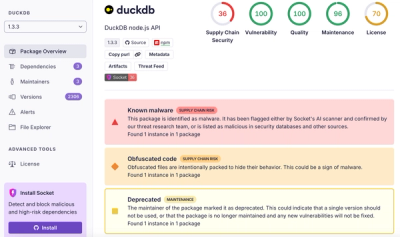
Product
Introducing Tier 1 Reachability: Precision CVE Triage for Enterprise Teams
Socket’s new Tier 1 Reachability filters out up to 80% of irrelevant CVEs, so security teams can focus on the vulnerabilities that matter.
adaptableblotter
Advanced tools
Powerful data-agnostic HTML5 datagrid add-on that sits on top of an underlying grid component and provides all the rich functionality that advanced users expect from their grids and blotters
Repository for the Core Adaptable Blotter HTML5 version - AdaptableBlotter.JS - developed by Adaptable Tools.
AdaptableBlotter.JS is a powerful DataGrid add-on that integrates with the leading datagrid components and provides all the additional, rich functionality that financial and other advanced users expect from their grids and blotters.
It offers - out of the box - incredibly powerful searching, filtering, sorting, styling and editing functionality. It also provides unparalleled validation and audit functions, vital in the current regulatory and compliance environment. Try it out for yourself at https://demo.adaptableblotter.com.
Grid components supported include:
More grid components are being added all the time so contact us if you would like us to implement your favourite HTML5 grid control.
AdaptableBlotter.JS is fully data agnostic and can work with any data set you provide it with. It is suitable for all data, all asset classes, all grid types, all locations and all use cases.
There are additional React and Angular wrappers - please see the relevant packages.
To install Adaptable Blotter via npm, run:
npm install adaptableblotter
In order for the AdaptableBlotter to look right, you have to import the index.css file
import "adaptableblotter/index.css"
This contains the structural styles and the (default) light theme.
For the dark theme, you also have to import
import "adaptableblotter/themes/dark.css"
So if you want the dark theme in your app, you have to do
import "adaptableblotter/index.css"
import "adaptableblotter/themes/dark.css"
This makes both the light and the dark themes available. You can also write your own custom theme for the AdaptableBlotter - see the section below for this.
A theme is basically a collection of css variables that the AdaptableBlotter exposes, and you can customise. You can have more css theme files imported in the app without them overriding each-other.
When the AdaptableBlotter applies a theme, it sets the ab--theme-<THEME_NAME> css className on the document HTML element - so only one theme will be applied at any given time.
In order to write a theme, let's call it blue, you have to define it with the following css:
html.ab--theme-blue {
--ab-theme-loaded: blue;
}
so basically
html.ab--theme-<THEME_NAME> {
--ab-theme-loaded: <THEME_NAME>;
}
There are a number of css variables that are available for customising a theme - see below (it's the contents of the dark theme)
html.ab--theme-dark {
/* this is here so we detect when the dark theme has been correctly loaded */
--ab-theme-loaded: dark;
/* the background for the whole AdaptableBlotter Dashboard - only used once */
--ab-dashboard__background: #232323;
--ab-cmp-input--disabled__background:#b6b7b8;
/* default background color to be used in dialogs, panels, inputs, etc */
--ab-color-defaultbackground: #3e444c;
/* color for text displayed on the default background */
--ab-color-text-on-defaultbackground: #f7f7f7;
/* the most used color - used for example, in dashboard toolbars + a light and dark variation */
--ab-color-primary: #262d2f;
--ab-color-primarylight: #2d3537;
--ab-color-primarydark: #1c2021;
/* color for text displayed over the primary color */
--ab-color-text-on-primary: #f7f7f7;
/* a color not so often used - mostly used for making things stand out - used for example, in wizard dialog headers + a light and dark variation */
--ab-color-secondary: #f7f7f7;
--ab-color-secondarylight: #07456d;
--ab-color-secondarydark: #f7f7f7;
/* color for text displayed over the secondary color */
--ab-color-text-on-secondary: #262d2f;
--ab-color-text-on-secondarylight: #f7f7f7;
}
In adition to the above variables, the following are also available
html.ab--theme-my-theme {
--ab-theme-loaded: my-theme;
/* we define a set of spacings, which you can customise to suit your needs */
--ab-space-0: 0px;
--ab-space-1: 4px;
--ab-space-2: 8px;
--ab-space-3: 16px;
--ab-space-4: 32px;
--ab-space-5: 64px;
--ab-space-6: 128px;
--ab-space-7: 256px;
/* also a set of font sizes */
--ab-font-size-0: 0.5rem; /* 8px for 1rem=16px */
--ab-font-size-1: 0.625rem; /* 10px for 1rem=16px */
--ab-font-size-2: 0.75rem; /* 12px for 1rem=16px */
--ab-font-size-3: 0.875rem; /* 14px for 1rem=16px */
--ab-font-size-4: 1rem;
/* use this to specify the font family you want for the blotter */
--ab__font-family: inherit;
/* customise the border radius for some of the AdaptableBlotter elements */
--ab__border-radius: var(--ab-space-1);
}
That's all the css you have to write for defining a theme - in fact, you can choose which of the above colors/variables to define - you don't have to define them all. Start incrementally, and work your way up as you need - use the dark theme as an example.
The Adaptable Blotter is a commercial product and requires a purchased licence for use.
The Adaptable Blotter licence covers both AdaptableBlotter.NET and AdaptableBlotter.JS versions, and offers regular updates and full support.
If you wish to evaluate the Adaptable Blotter before purchase, please contact us requesting a Trial Licence.
Licences are sold to end-users typically in 'bands' so the price per user falls as volumne increases. There is also a Universal option which gives unlimited usage to unlimited users.
Note: The Adaptable Blotter licence does not include the licence for the underlying grid - if you use a vendor grid that requires a commerical licence, you must purchase that separately.
Please contact the Adaptable Tools Sales Team at sales@adaptabletools.com for more information.
import AdaptableBlotter from 'adaptableblotter/agGrid';
import 'ag-grid-community/dist/styles/ag-grid.css';
import 'ag-grid-community/dist/styles/ag-theme-balham.css';
import 'adaptableblotter/base.css';
import 'adaptableblotter/themes/light.css';
To see AdaptableBlotter.JS in action visit https://demo.adaptableblotter.com where you can see the Adaptable Blotter running againt a number of different dummy data sets using various underlying DataGrids.
Further information about AdaptableBlotter.JS is available at www.adaptabletools.com. And there is detailed Help at https://adaptabletools.zendesk.com/hc/en-us.
Developers can see how to access the Adaptable Blotter programmatically at https://api.adaptableblotter.com
For all enquiries please email the Adaptable Tools Support Team at support@adaptabletools.com.
FAQs
Powerful data-agnostic HTML5 datagrid add-on that sits on top of an underlying grid component and provides all the rich functionality that advanced users expect from their grids and blotters
The npm package adaptableblotter receives a total of 3 weekly downloads. As such, adaptableblotter popularity was classified as not popular.
We found that adaptableblotter demonstrated a not healthy version release cadence and project activity because the last version was released a year ago. It has 3 open source maintainers collaborating on the project.
Did you know?

Socket for GitHub automatically highlights issues in each pull request and monitors the health of all your open source dependencies. Discover the contents of your packages and block harmful activity before you install or update your dependencies.

Product
Socket’s new Tier 1 Reachability filters out up to 80% of irrelevant CVEs, so security teams can focus on the vulnerabilities that matter.

Research
/Security News
Ongoing npm supply chain attack spreads to DuckDB: multiple packages compromised with the same wallet-drainer malware.

Security News
The MCP Steering Committee has launched the official MCP Registry in preview, a central hub for discovering and publishing MCP servers.